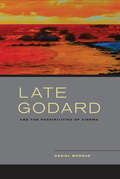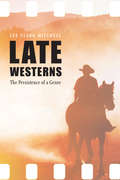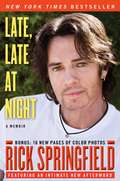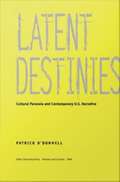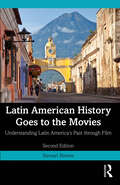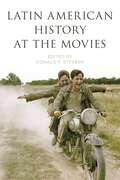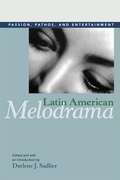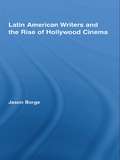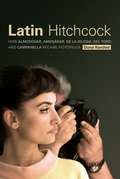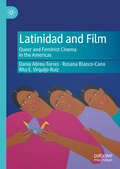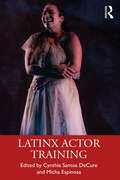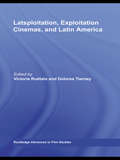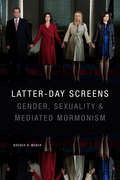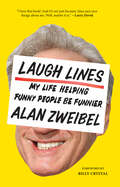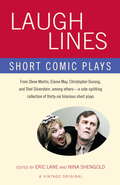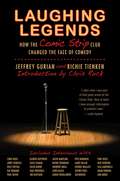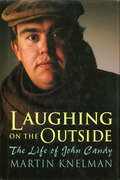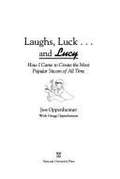- Table View
- List View
Late Godard and the Possibilities of Cinema
by Daniel MorganWith Late Godard and the Possibilities of Cinema, Daniel Morgan makes a significant contribution to scholarship on Jean-Luc Godard, especially his films and videos since the late 1980s, some of the most notoriously difficult works in contemporary cinema. Through detailed analyses of extended sequences, technical innovations, and formal experiments, Morgan provides an original interpretation of a series of several internally related films--Soigne ta droite (Keep Your Right Up, 1987), Nouvelle vague (New Wave, 1990), and Allemagne 90 neuf zéro (Germany 90 Nine Zero, 1991)--and the monumental late video work, Histoire(s) du cinéma (1988-1998). Taking up a range of topics, including the role of nature and natural beauty, the relation between history and cinema, and the interactions between film and video, the book provides a distinctive account of the cinematic and intellectual ambitions of Godard's late work. At the same time, Late Godard and the Possibilities of Cinema provides a new direction for the fields of film and philosophy by drawing on the idealist and romantic tradition of philosophical aesthetics, which rarely finds an articulation within film studies. In using the tradition of aesthetics to illuminate Godard's late films and videos, Morgan shows that these works transform the basic terms and categories of aesthetics in and for the cinema.
Late Star Trek: The Final Frontier in the Franchise Era (Mass Markets: Storyworlds Across Media)
by Adam KotskoHow Star Trek&’s twenty-first-century reinventions illuminate the unique challenges and opportunities of franchise-style corporate storytellingLate Star Trek explores the beloved science fiction franchise&’s repeated attempts to reinvent itself after the end of its 1990s golden age. Beginning with the prequel series Enterprise, Adam Kotsko analyzes the wealth of content set within Star Trek&’s sprawling continuity—including authorized books, the three &“Kelvin Timeline&” films, and the streaming series Discovery, Picard, Lower Decks, Prodigy, and Strange New Worlds—along with fan discourse, to reflect on the perils and promise of the franchise as a unique form of storytelling. Significantly including the licensed novels and comic books that fill out the Star Trek universe for its fans, Kotsko brings the multiple productions of the early twenty-first century together as a unified whole rather than analyzing them in their current stratified view. He argues that the variety of styles and approaches in this tumultuous era of Star Trek history provides the perfect opportunity to reflect on the nature of the franchise storyworlds that now dominate popular culture. By taking the spin-offs and tie-ins seriously as creative attempts to tell a new story within an established universe, Late Star Trek highlights creative triumphs as well as the tendency for franchise faithfulness to get in the way of creating engaging characters and ideas. Arguing forcefully against the prevailing consensus that franchises are a sign of cultural decay, Kotsko contends that the Star Trek universe exemplifies an approach to storytelling that has been perennial across cultures. Instead, he finds that what limits creativity within franchises is not their reliance on the familiar but their status as modern myths, held not as common cultural heritage but rather owned as corporate intellectual property. Retail e-book files for this title are screen-reader friendly with images accompanied by short alt text and/or extended descriptions.
Late Westerns: The Persistence of a Genre (Postwestern Horizons)
by Lee Clark MitchellFor more than a century the cinematic Western has been America’s most familiar genre, always teetering on the verge of exhaustion and yet regularly revived in new forms. Why does this outmoded vehicle—with the most narrowly based historical setting of any popular genre—maintain its appeal? In Late Westerns Lee Clark Mitchell takes a position against those critics looking to attach “post” to the all-too-familiar genre. For though the frontier disappeared long ago, though men on horseback have become commonplace, and though films of all sorts have always, necessarily, defied generic patterns, the Western continues to enthrall audiences. It does so by engaging narrative expectations stamped on our collective consciousness so firmly as to integrate materials that might not seem obviously “Western” at all. Through plot cues, narrative reminders, and even cinematic frameworks, recent films shape interpretive understanding by triggering a long-standing familiarity audiences have with the genre. Mitchell’s critical analysis reveals how these films engage a thematic and cinematic border-crossing in which their formal innovations and odd plots succeed deconstructively, encouraging by allusion, implication, and citation the evocation of generic meaning from ingredients that otherwise might be interpreted quite differently. Applying genre theory with close cinematic readings, Mitchell posits that the Western has essentially been “post” all along.
Late, Late at Night: A Memoir
by Rick SpringfieldIn a searingly candid memoir which he authored himself, Grammy Award-winning pop icon Rick Springfield pulls back the curtain on his image as a bright, shiny, happy performer to share the startling story of his rise and fall and rise in music, film, and television and his lifelong battle with depression. In the 1980s, singer-songwriter and actor Rick Springfield seemed to have it all: a megahit single in “Jessie’s Girl,” sold-out concert tours, follow-up hits that sold more than 17 million albums and became the pop soundtrack for an entire generation, and 12 million daily viewers who avidly tuned in to General Hospital to swoon over his portrayal of the handsome Dr. Noah Drake. Yet lurking behind his success as a pop star and soap opera heartthrob and his unstoppable drive was a moody, somber, and dark soul, one filled with depression and insecurity. In Late, Late at Night, the memoir his millions of fans have been waiting for, Rick takes readers inside the highs and lows of his extraordinary life. By turns winningly funny and heartbreakingly sad, every page resonates with Rick’s witty, wry, self-deprecating, brutally honest voice. On one level, he reveals the inside story of his ride to the top of the entertainment world. On a second, deeper level, he recounts with unsparing candor the forces that have driven his life, including his longtime battle with depression and thoughts of suicide, the shattering death of his father, and his decision to drop out at the absolute peak of fame. Having finally found a more stable equilibrium, Rick’s story is ultimately a positive one, deeply informed by his passion for creative expression through his music, a deep love of his wife of twenty-six years and their two sons, and his life-long quest for spiritual peace.
Lateinamerikaberichterstattung der deutschen Presse: Struktur und Entstehungsbedingungen
by Regina CazzamattaDas vorliegende Buch zu Struktur und Entstehungsbedingung Lateinamerikas in der deutschen Presse basiert auf einer in dieser Dimension bis heute nicht vorhandenen empirischen Grundlage. Die Studie basiert auf 21.929 Beiträgen, von denen mithilfe einer geschichteten Stichprobe 4.164 in die Analyse einbezogen, ausgewertet und mit Korrespondenten-Interviews kombiniert wurden. Sie beleuchtet die Auswahlkriterien und Mechanismen der Berichterstattung zu Lateinamerika und füllte eine Forschungslücke zu einem Thema, das außenpolitisch extrem relevant ist. Das Buch betrachtet Themen und Merkmale des Mediendiskurses in kombinierter Form, stellt Länderprofile dar und sucht nach theoretischen Erklärungen für die Bildkonstruktionen. Die Studie kommt zum Ergebnis, dass es das Lateinamerikabild in der deutschen Presse nicht gibt, sondern sich eine Perzeption nach Ländern und Landesgruppen ausdifferenziert lässt. Die Forschungsarbeit ist über das Fachgebiet Medien- und Kommunikationswissenschaft hinaus interessant und bedeutet einen Gewinn für die Lateinamerikaforschung in Deutschland.
Latent Destinies: Cultural Paranoia and Contemporary U.S. Narrative
by Patrick O'DonnellLatent Destinies examines the formation of postmodern sensibilities and their relationship to varieties of paranoia that have been seen as widespread in this century. Despite the fact that the Cold War has ended and the threat of nuclear annihilation has been dramatically lessened by most estimates, the paranoia that has characterized the period has not gone away. Indeed, it is as if--as O'Donnell suggests--this paranoia has been internalized, scattered, and reiterated at a multitude of sites: Oklahoma City, Waco, Ruby Ridge, Bosnia, the White House, the United Nations, and numerous other places. O'Donnell argues that paranoia on the broadly cultural level is essentially a narrative process in which history and postmodern identity are negotiated simultaneously. The result is an erasure of historical temporality--the past and future become the all-consuming, self-aware present. To explain and exemplify this, O'Donnell looks at such books and films as Libra, JFK, The Crying of Lot 49, The Truman Show, Reservoir Dogs, Empire of the Senseless, Oswald's Tale, The Executioner's Song, Underworld, The Killer Inside Me, and Groundhog Day. Organized around the topics of nationalism, gender, criminality, and construction of history, Latent Destinies establishes cultural paranoia as consonant with our contradictory need for multiplicity and certainty, for openness and secrecy, and for mobility and historical stability. Demonstrating how imaginative works of novels and films can be used to understand the postmodern historical condition, this book will interest students and scholars of American literature and cultural studies, postmodern theory, and film studies.
Latin American Cinema
by Paul A. Schroeder RodríguezThis book charts a comparative history of Latin America's national cinemas through ten chapters that cover every major cinematic period in the region: silent cinema, studio cinema, neorealism and art cinema, the New Latin American Cinema, and contemporary cinema. Schroeder Rodríguez weaves close readings of approximately fifty paradigmatic films into a lucid narrative history that is rigorous in its scholarship and framed by a compelling theorization of the multiple discourses of modernity. The result is an essential guide that promises to transform our understanding of the region's cultural history in the last hundred years by highlighting how key players such as the church and the state have affected cinema's unique ability to help shape public discourse and construct modern identities in a region marked by ongoing struggles for social justice and liberation.
Latin American Documentary Film in the New Millennium
by María Guadalupe Arenillas Michael J. LazzaraNearly two decades into the new millennium, Latin American documentary film is experiencing renewed vibrancy and visibility on the global stage. While elements of the combative, politicized cinema of the 1960s and 1970s remain, the region's production has become increasingly subjective, reflexive, and experimental, though perhaps no less political. At the same time, Latin American filmmakers both respond to and shape global tendencies in the genre. This book highlights the richness and heterogeneity of Latin American documentary film, surveys a broad range of national contexts, styles, and practices, and expands current debates on the genre. Thematic sections address the "subjective turn" of the 1990s and 2000s and the move beyond it; the ethics of the encounter between the filmmaker and the subject/object of his or her gaze; and the performance of truth and memory, a particularly urgent topic as Latin American countries have transitioned from dictatorship to democracy.
Latin American History Goes to the Movies: Understanding Latin America's Past through Film
by Stewart BrewerThis new edition of Latin American History Goes to the Movies uses a variety of feature films as a method of studying key historical themes in Latin America, from pre-Columbian cultures to contemporary debates. The book provides historical context as a way of interpreting Latin American filmography, offering multiple classroom viewing options per chapter theme. Each chapter is dedicated to a central concept or issue, such as stereotypes, conquest and colonialism, revolution, religion, gender, and politics. The second edition includes four additional chapters on dictatorships, LGBTQIA+ issues, the environment, and Indigenous peoples. Twenty new films, including La Fiesta del Chivo, Fresa y Chocolate, Embrace of the Serpent, and Roma appear throughout this edition, presenting additional perspectives and updates for today’s readers. The discussions of films and the history behind them offer a flexible and nuanced approach to understanding Latin American cultures, differentiating between stereotypical depictions and the realities of history. Concise and accessible, Latin American History Goes to the Movies is a unique resource for students and instructors in Latin American history and film studies to analyse developments in Latin America throughout previous centuries.
Latin American History at the Movies
by Edited by Donald F. StevensMovies are meant to be entertaining, but they can also be educational. People are naturally curious to know how much of what they see on their screens might be historically true. In Latin American History at the Movies, experts on Latin America focus on five centuries of history as portrayed in feature films. An introduction on the visual presentation of the past in movies sets the stage for essays that explore sixteen of the best feature films on Latin America made from the 1980s to the present.
Latin American Melodrama: Passion, Pathos, and Entertainment
by Darlene J. SadlierLike their Hollywood counterparts, Latin American film and TV melodramas have always been popular and highly profitable. The first of its kind, this anthology engages in a serious study of the aesthetics and cultural implications of Latin American melodramas. Written by some of the major figures in Latin American film scholarship, the studies range across seventy years of movies and television within a transnational context, focusing specifically on the period known as the "Golden Age" of melodrama, the impact of classic melodrama on later forms, and more contemporary forms of melodrama. An introductory essay examines current critical and theoretical debates on melodrama and places the essays within the context of Latin American film and media scholarship. Contributors are Luisela Alvaray, Mariana Baltar, Catherine L. Benamou, Marvin D'Lugo, Paula Félix-Didier, Andrés Levinson, Gilberto Perez, Darlene J. Sadlier, Cid Vasconcelos, and Ismail Xavier.
Latin American Writers and the Rise of Hollywood Cinema (Routledge Studies in Twentieth-Century Literature)
by Jason BorgeThis book analyzes the initial engagement with Hollywood by key Latin American writers and intellectuals during the first few decades of the 20th century. The film metropolis presented an ambiguous, multivalent sign for established figures like Horacio Quiroga, Alejo Carpentier and Mário de Andrade, as well as less renowned writers like the Mexican Carlos Noriega Hope, the Chilean Vera Zouroff and the Cuban Guillermo Villarronda. Hollywood’s arrival on the scene placed such writers in a bind, as many felt compelled to emulate the "artistry" of a medium dominated by a nation posing a symbolic affront to Latin American cultural and linguistic autonomy as well as the region’s geopolitical sovereignty. The film industry thus occupied a crucial site of conflict and reconciliation between aesthetics and politics.
Latin Hitchcock: How Almodóvar, Amenábar, De la Iglesia, Del Toro and Campanella Became Notorious
by Dona KercherThis study explores how five major Spanish and Latino directors modeled their early careers on Hitchcock and his film aesthetics.
Latin Hitchcock: How Almodóvar, Amenábar, De la Iglesia, Del Toro, and Campanella Became Notorious
by Dona KercherThis study explores how five major directors—Pedro Almodóvar, Alejandro Amenábar, Alex de la Iglesia, Guillermo del Toro, and Juan José Campanella—modeled their early careers on Hitchcock and his film aesthetics. In shadowing Hitchcock, their works embraced the global aspirations his movies epitomize. Each section of the book begins with an extensive study, based on newspaper accounts, of the original reception of Hitchcock's movies in either Spain or Latin America and how local preferences for genre, glamour, moral issues, and humor affected their success. The text brings a new approach to world film history, showcasing both the commercial and artistic importance of Hitchcock in Spain and Latin America
Latin Looks: Images of Latinas and Latinos in the U.S. Media
by Clara E RodriguezWhat are “Latin looks”? A Latin look may seem at first blush to be something that everyone recognizes—brunette, sensual, expressive, animated, perhaps threatening. But upon reflection, we realize that these are the images that are prevalent in the media, while the reality in Latino communities is of a rich diversity of people and images. This book brings together a selection of the best, the most interesting, and the most analytically sophisticated writing on how Latinos have been portrayed in movies, television, and other media since the early years of the twentieth century and how images have changed over time in response to social and political change. Particular emphasis is given to representations of class, gender, color, race, and the political relationship between the United States and Latin America. Together the essays offer a corrective lens for interpreting how images are created, perpetuated, and manipulated.
Latinidad and Film: Queer and Feminist Cinema in the Americas
by Rosana Blanco-Cano Dania Abreu-Torres Rita E. Urquijo-RuizThis book provides an analysis of Latinidad in Latin American and U.S. Latinx films by women and/or LGBTQ directors from 1991 to 2016. Challenging traditional notions of gender roles, family, and national identities, it discusses how film directors are broadening the canon and producing provocative work that challenges the boundaries of identity. Utilizing a feminist and queer lens, this book is intended to demonstrate the dynamic interactions between individual agency, choices, and freedom from the communities represented. The book's organization in three parts reflects a common core of the Latin American and U.S. Latinx experiences, unifying all these films in the hope of creating a better understanding of these geographical regions and their people.
Latinx Actor Training
by Cynthia Santos DeCure Micha EspinosaLatinx Actor Training presents essays and pioneering research from leading Latinx practitioners and scholars in the United States to examine the history and future of Latino/a/x/e actor training practices and approaches. Born out of the urgent need to address the inequities in academia and the industry as Latinx representation on stage and screen remains disproportionately low despite population growth; this book seeks to reimagine and restructure the practice of actor training by inviting deep investigation into heritage and identity practices. Latinx Actor Training features contributions covering current and historical acting methodologies, principles, and training, explorations of linguistic identity, casting considerations, and culturally inclusive practices that aim to empower a new generation of Latinx actors and to assist the educators who are entrusted with their training. This book is dedicated to creating career success and championing positive narratives to combat pervasive and damaging stereotypes. Latinx Actor Training offers culturally inclusive pedagogies that will be invaluable for students, practitioners, and scholars interested in the intersections of Latinx herencia (heritage), identity, and actor training.
Latsploitation, Exploitation Cinemas, and Latin America (Routledge Advances in Film Studies)
by Dolores Tierney Victoria RuétaloExploring the much neglected area of Latin American exploitation cinema, this anthology challenges established continental and national histories and canons which often exclude exploitation cinema due to its perceived ‘low’ cultural status. It argues that Latin American exploitation cinema makes an important aesthetic and social contribution to the larger body of Latin American cinema – often competing with Hollywood and more mainstream national cinemas in terms of popularity.
Latter-day Screens: Gender, Sexuality, and Mediated Mormonism
by Brenda R. WeberFrom Sister Wives and Big Love to The Book of Mormon on Broadway, Mormons and Mormonism are pervasive throughout American popular media. In Latter-day Screens, Brenda R. Weber argues that mediated Mormonism contests and reconfigures collective notions of gender, sexuality, race, spirituality, capitalism, justice, and individualism. Focusing on Mormonism as both a meme and an analytic, Weber analyzes a wide range of contemporary media produced by those within and those outside of the mainstream and fundamentalist Mormon churches, from reality television to feature films, from blogs to YouTube videos, and from novels to memoirs by people who struggle to find agency and personhood in the shadow of the church's teachings. The broad archive of mediated Mormonism contains socially conservative values, often expressed through neoliberal strategies tied to egalitarianism, meritocracy, and self-actualization, but it also offers a passionate voice of contrast on behalf of plurality and inclusion. In this, mediated Mormonism and the conversations on social justice that it fosters create the pathway toward an inclusive, feminist-friendly, and queer-positive future for a broader culture that uses Mormonism as a gauge to calibrate its own values.
Laugh Lines: My Life Helping Funny People Be Funnier
by Alan ZweibelWith his tender, funny memoir of four decades in the business, one of the first writers for Saturday Night Live traces the history of American comedy. Alan Zweibel started his comedy career selling jokes for seven dollars apiece to the last of the Borscht Belt standups. Then one night, despite bombing on stage, he caught the attention of Lorne Michaels and became one of the first writers at Saturday Night Live, where he penned classic material for Gilda Radner, John Belushi, and all of the original Not Ready For Prime Time Players. From SNL, he went on to have a hand in a series of landmark shows—from It’s Garry Shandling’s Show to Curb Your Enthusiasm. Throughout the pages of Laugh Lines Zweibel weaves together his own stories and interviews with his friends and contemporaries, including Richard Lewis, Eric Idle, Bob Saget, Mike Birbiglia, Sarah Silverman, Judd Apatow, Dave Barry, Carl Reiner, and more. The book also features a charming foreword from his friend of forty-five years Billy Crystal, with whom he co-wrote and co-produced the upcoming film Here Today that stars Crystal and Tiffany Haddish. Laugh Lines is a warmhearted cultural memoir of American comedy.“In Laugh Lines, Zweibel looks back, affectionately and informatively, at a career that began when he was a young deli worker grinding out jokes for old-school borscht belt comedians in his spare time, and that, after his “S.N.L.” years, included rewarding collaborations with, among others, Garry Shandling, Billy Crystal, Martin Short, Larry David and Dave Barry. . . . Fascinating.” —New York Times“Any comedy fan will thrill to see the contemporary art's invention through the eyes of consummate funny man Alan Zweibel. He takes you behind the velvet rope and makes you weep for all those artists who made us laugh. Screamingly funny—also very moving. A classic.” —Mary Karr“Alan Zweibel is legendary among us comedians. He is the man who delivers comedy with an emotional clout that makes him respected and revered.” —Steve Martin
Laugh Lines: Short Comic Plays
by Eric Lane Nina ShengoldThis one-of-a-kind anthology features thirty-six hilarious short plays by major American playwrights and emerging new voices, all guaranteed to send readers and audiences into peals of laughter. From the surrealistic wit of Steve Martin's "The Zig-Zag Woman" to the biting political satire of Steven Dietz's "The Spot," from Christopher Durang's wonderfully loopy "Wanda's Visit" to Shel Silverstein's supremely twisted "The Best Daddy," there's something in here to make everyone laugh. There are plays for casts of all sizes, from monologues to large ensembles, with diverse and challenging roles for actors of every age and type. Even the titles are funny: Mark O'Donnell's "There Shall Be No Bottom (a bad play for worse actors)," Elaine May's "The Way of All Fish," and Alan Ball's "Your Mother's Butt. " A bonanza for theatergoers, performers, and comedy fans,Laugh Lineswill bring down the house. From the Trade Paperback edition.
Laughing Legends: How The Comic Strip Club Changed The Face of Comedy
by Chris Rock Jeffrey Gurian Richie TienkenOnce in a lifetime a venue comes along that changes show business dramatically, that fosters growth and camaraderie, experimentation and freedom. The Comic Strip is one of those places, and Laughing Legends is an inside look at how it all happened, straight from the mouths of the stars who built their careers on its stage. Owner Richie Tienken and a wealth of comics open their hearts and souls to share their most intimate memories, the laughs and tears, the good times and the bad, in order to paint an all-encompassing, behind-the-scenes history of this iconic club. Interviews include famous comedians, such as:Jerry SeinfeldGilbert GottfriedPaul ReiserLisa LampanelliGeorge WallaceBilly CrystalJim BreuerSusie EssmanLewis BlackRay RomanoAnd many more!Relive the excitement as these comics explain how they came to belong to the Comic Strip family, and how they went on to enjoy huge careers, bringing laughter to millions of people all over the world. This book is a must for any comedian or comedy lover's library!
Laughing Out Loud: Writing the Comedy-Centered Screenplay
by Andrew HortonWhoever wrote "Make 'em laugh!" knew that it's easier said than done. But people love to laugh, and good comedy will always sell. With the help of this complete and entertaining guide, writers and would-be writers for film and television can look forward to writing comedy that goes far beyond stereotypic jokes and characters. In Laughing Out Loud, award-winning screenwriter and author Andrew Horton blends history, theory, and analysis of comedy with invaluable advice.Using examples from Chaplin to Seinfeld, Aristophanes to Woody Allen, Horton describes comedy as a perspective rather than merely as a genre and then goes on to identify the essential elements of comedy. His lively overview of comedy's history traces its two main branches—anarchistic comedy and romantic comedy—from ancient Greece through contemporary Hollywood, by way of commedia dell'arte, vaudeville, and silent movies. Television and international cinema are included in Horton's analysis, which leads into an up-close review of the comedy chemistry in a number of specific films and television shows.The rest of the book is a practical guide to writing feature comedy and episodic TV comedy, complete with schedules and exercises designed to unblock any writer's comic potential. The appendices offer tips on networking, marketing, and even producing comedies, and are followed by a list of recommended comedies and a bibliography.
Laughing on the Outside: The Life of John Candy
by Martin Knelman“A truthful look at John Candy—affectionate but unblinking.” —San Francisco ExaminerFunny and gentle, John Candy was loved by millions of movie fans for playing true-to-life characters. Whether as the irrepressible bon vivant in Splash, the misunderstood slob in Uncle Buck, or the generous lonely salesman in Planes, Trains, and Automobiles, John Candy struck a perfect balance between self-deprecating humor and irresistible, emotional warmth. In this compassionate portrait of John Candy, award-winning journalist Martin Knelman reveals that behind the scenes, beneath the booming laughter, a man blessed by genius and goodness of heart was ultimately and sadly undermined by self-doubt and misguided ambition.“Laughing on the Outside celebrates the genius of John Candy.” —Vanity Fair“Candy’s is ultimately a sad story, one that Knelman has made sympathetic and memorable, too.” —Booklist“This book is a must for Candy’s fans and an ought-to for everyone else.” —Toronto Globe and Mail“Everyone knew the happy-go-lucky comic, but Knelman shows us the sad clown underneath, which ultimately enriches the image.” —Toronto Star
Laughs, Luck...and Lucy: How I Came to Create the Most Popular Sitcom of All Time
by Jess Oppenheimer Gregg OppenheimerLaughs indeed as Jess Oppenheimer charts his rise from radio station gofer to inventor of the sitcom, as he winds up writing--then producing--Lucille Ball's show, first on radio, then on television. Luck, too, as the author recounts the good fortune that has him, within minutes of arrival in Hollywood, sitting down at a lunch counter and getting a tip that secures a job within days and a career for life. Ironic, too, that this inveterate TV writer had to be cajoled for years to set down these Hollywood heyday memoirs. He never finished, and it was left to son Gregg to complete the book.
